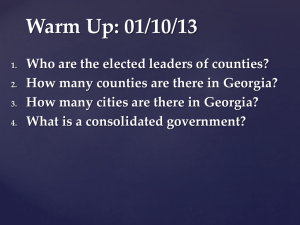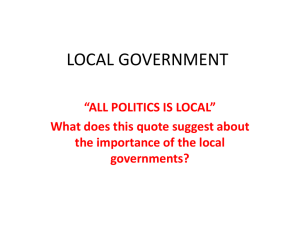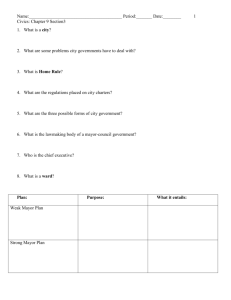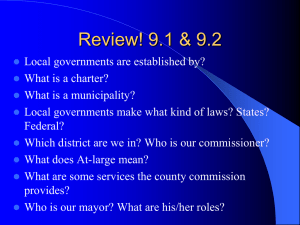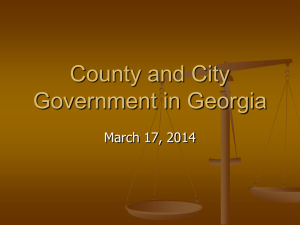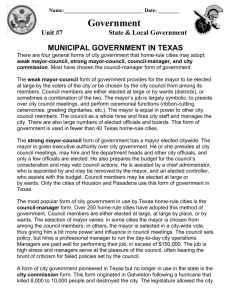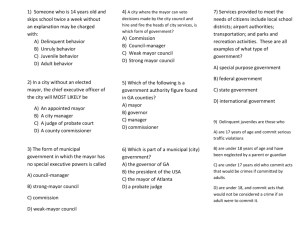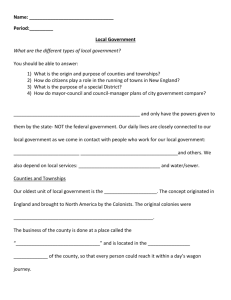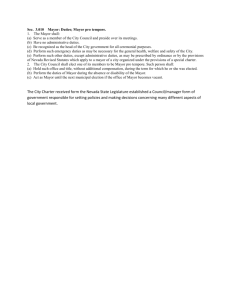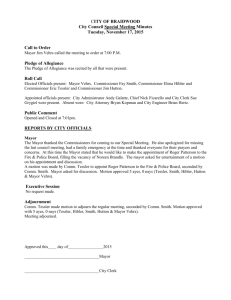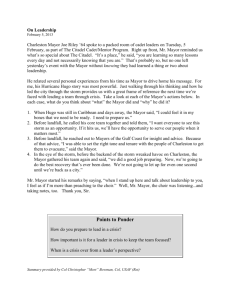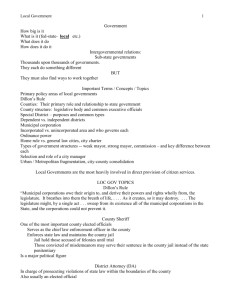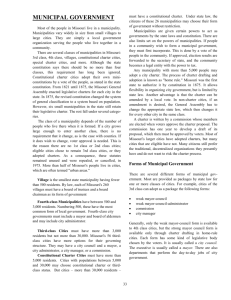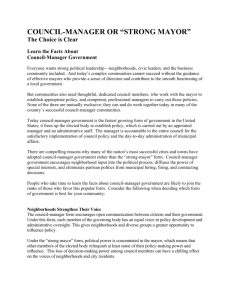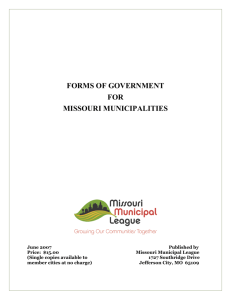CITY GOVERNMENT More Americans live under city government
advertisement
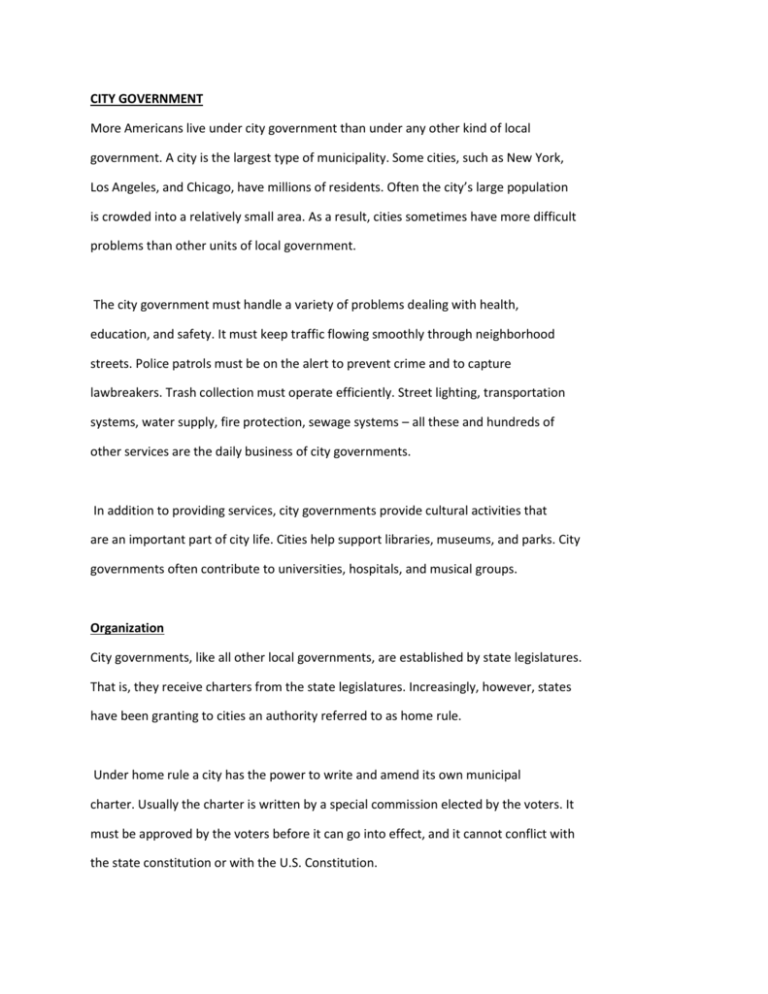
CITY GOVERNMENT More Americans live under city government than under any other kind of local government. A city is the largest type of municipality. Some cities, such as New York, Los Angeles, and Chicago, have millions of residents. Often the city’s large population is crowded into a relatively small area. As a result, cities sometimes have more difficult problems than other units of local government. The city government must handle a variety of problems dealing with health, education, and safety. It must keep traffic flowing smoothly through neighborhood streets. Police patrols must be on the alert to prevent crime and to capture lawbreakers. Trash collection must operate efficiently. Street lighting, transportation systems, water supply, fire protection, sewage systems – all these and hundreds of other services are the daily business of city governments. In addition to providing services, city governments provide cultural activities that are an important part of city life. Cities help support libraries, museums, and parks. City governments often contribute to universities, hospitals, and musical groups. Organization City governments, like all other local governments, are established by state legislatures. That is, they receive charters from the state legislatures. Increasingly, however, states have been granting to cities an authority referred to as home rule. Under home rule a city has the power to write and amend its own municipal charter. Usually the charter is written by a special commission elected by the voters. It must be approved by the voters before it can go into effect, and it cannot conflict with the state constitution or with the U.S. Constitution. Home rule gives cities the power to manage their own affairs and to deal with their own local problems. As such, it limits the amount of state interference in local concerns. Many people believe that home rule strengthens local government and increases citizen interest in city affairs. Depending on its charter, a city government may take one of three forms: the mayor-council government, the commission government, or the council-manager government. A city charter is a basic plan for a local governmental unit that defines its powers, responsibilities, and organization. Below are some charts showing how these various forms of city government are organized. Mayor-Council Government The oldest and most common form of city government is the mayor-council plan. In this kind of government, the lawmaking body is called the city council. The chief executive of the city government is the mayor, who sees that city laws, or ordinances, are enforced. The mayor and members of the city council are elected by the voters of the city. Their term of office varies, but in most cases it is either two years or four years. Under the mayor-council form of government, the city is divided into several districts called wards. Each ward elects one member of the council. In some cities, though, the people elect several council members-at-large. That is, the council members are chosen by all the voters in the city. Almost all city councils are unicameral. City voters also elect other officials, including a treasurer, judges of the municipal courts, a city attorney, or solicitor, and tax assessors. Other officials, either elected or appointed, are the heads of departments for police, fire fighting, traffic, water, health and welfare, parks and playgrounds, civil defense, housing, licenses, and purchasing. Weak-Mayor Plan: During the nation’s early years, the American people were hesitant to grant power to their mayors. The experience of colonists with British governors who did not listen to the people’s wishes made Americans fear officials who might have too much power. For this reason, some cities developed the weak-mayor plan. Under the weak-mayor plan of city government, the city council holds more power than the mayor. For example, the council appoints the heads of city departments. These heads report directly to the city council. In addition, the mayor must obtain the consent of the council to spend money or take other actions. The weak-mayor plan often results in conflicts between the mayor and the council. Strong-Mayor Plan: In recent years, most cities with a mayor-council form of organization have tried to make their governments more efficient by following the strong-mayor plan. Under the strong-mayor plan, the mayor has chief responsibility for running the city’s government. The mayor appoints most of the city officials and can dismiss them if they do not do a good job. The mayor can veto bills passed by the council. It is the mayor’s responsibility to draw up the city budget. When the council has approved a budget, the mayor must see that the city’s money is spent properly. Under this strong-mayor plan, the mayor, as the city’s chief executive, takes the lead in carrying on the city’s business. Commission Government A new form of government grew out of a hurricane that struck Galveston, Texas, in 1900. A huge tidal wave swept across the city, flooding homes and businesses and causing millions of dollars in damages. About 6,000 city residents lost their lives. The city’s mayor and council were unable to handle the disaster. As a result, leading citizens in Galveston asked the state legislature for permission to set up a new form of city government. It was called the commission plan. Within a few years, this plan of government was adopted by several hundred other cities. Under the commission plan, a city is governed by a commission, usually consisting of five elected officials. The commission is the city’s lawmaking body as well as its executive body. The commission passes the city’s ordinances. Each commissioner heads a department of city government. Usually one commissioner is the head of the department of public safety, which includes the police and firefighters. Another commissioner, in charge of public works, must see that the city has an adequate supply of clean water and that the streets are kept in good repair. A third commissioner oversees the city’s finances, including tax collections. Another runs the public welfare department, which helps the city’s disadvantaged citizens. The health department is managed by a commissioner who supervises hospitals, clinics, and health inspectors. The commissioners meet as a group to make the city’s laws. Each commissioner, however, carries out the laws that apply to his or her own department. Either the voters or the commissioners choose one of the commissioners to be mayor. Except for presiding over meetings of the commission, the mayor has the same powers as other commissioners. In some cases the commission form of city government has shown certain disadvantages. The voters sometimes have found it impossible to elect officials who know how to run a department of the city’s government. In addition, there are activities of city government that can come under the jurisdiction of several departments. Sometimes commissioners disagree about who should handle these activities. Because of these problems, fewer than 175 cities now use the commission plan of government. Council-Manager Government In 1912, Sumter, South Carolina, was the first city to set up a council-manager plan of government. Today, this plan of government is used by a growing number of cities. Under the council-manager plan, voters elect a city council to act as the city’s lawmaking body. The council then appoints a city manager. The city manager, as the city’s chief executive, appoints the heads of the departments. They report to the city manager. Under this plan, the city is run by specially trained professionals, much like a big business firm. City managers are appointed, not elected, so that they will not take part in party politics or face any political pressure. They are given a free hand to run city governments efficiently and economically. If a city manager does not do a good job, the council may dismiss him or her and appoint a new manager. The council-manager plan of government has certain disadvantages. Some smaller cities cannot afford the salary required to hire a good manager. Also, some critics of the plan argue that cities are better governed when the voters themselves elect the officials who are to run their city’s government. How Governments Work Together You live under three levels of government – local, state, and federal. If each level of government paid no attention to the work of the others, life would become difficult and confusing. City governments might pass city laws that conflict with state laws. State governments might ignore federal laws. Citizens would not know which set of laws to obey. Division of Powers Fortunately, under the U.S. federal system of government, the powers of each level of government are clearly defined and understood. The Constitution of the United States is the supreme law of the land. All levels of government must obey it. State constitutions, in turn, set up rules that govern the people of each state. These state constitutions must not, of course, take away from the people any of the rights guaranteed in the U.S. Constitution. In local units of government, the powers defined for them are in the charters by the state legislatures. In this way, each level of government has its own work to do. Each level is given the powers needed to do its job. Why Governments Work Together Many problems call for cooperation among local, state, and federal governments. Consider, for example, the way the nation’s modern highway system was built. In colonial days, the building of a road was considered a local project. If the people of a town wanted a road, they had to build it themselves. As settlements spread westward, each county assumed the responsibility of building connecting roads. The counties called on local farmers and townspeople to supply the labor to build the roads. Local residents also provided money to hire workers. These early roads were often twisting and rutted, dusty in dry weather, and muddy after rain. They were, however, cheap to build and repair. Local governments could easily plan and pay for such roads. As the nation grew, highways were needed to connect the East with the growing West. In response, Congress voted to have the federal government build main roads to the West. City Governments Work Together Cities face many common challenges. For example, city governments are concerned about increasing funds for police, fire departments, and education. They look for ways to lessen air pollution and to dispose of trash safely. The U.S. Conference of Mayors meets regularly so that the nation’s mayors may compare problems and discuss possible solutions. As neighboring cities grow closer together, they often share problems. Government Competition Although cooperation among governments is growing, governments also compete with one another. For example, governments compete with citizens’ tax dollars. A person may have to pay income taxes to both state and federal governments. There may be a city income tax as well. Residents may also have to pay property taxes to their local governments. State and local governments may collect sales taxes. States compete with each other to attract industry. They offer businesses lower taxes, a good supply of labor, good highways, and favorable laws to encourage industry to move to their state. Cities compete for trade and industry in similar fashion. The federal government and federal laws sometimes seem to interfere or compete with local laws and customs. For example, the federal government may challenge the election procedures in a state or locality if such procedures conflict with federal law. The combined system of federal, state, and local governments is complex. It would be surprising if there were not instances of conflict. Only by working together, though, can the nation’s three levels of government fulfill their duty to serve the American people.
